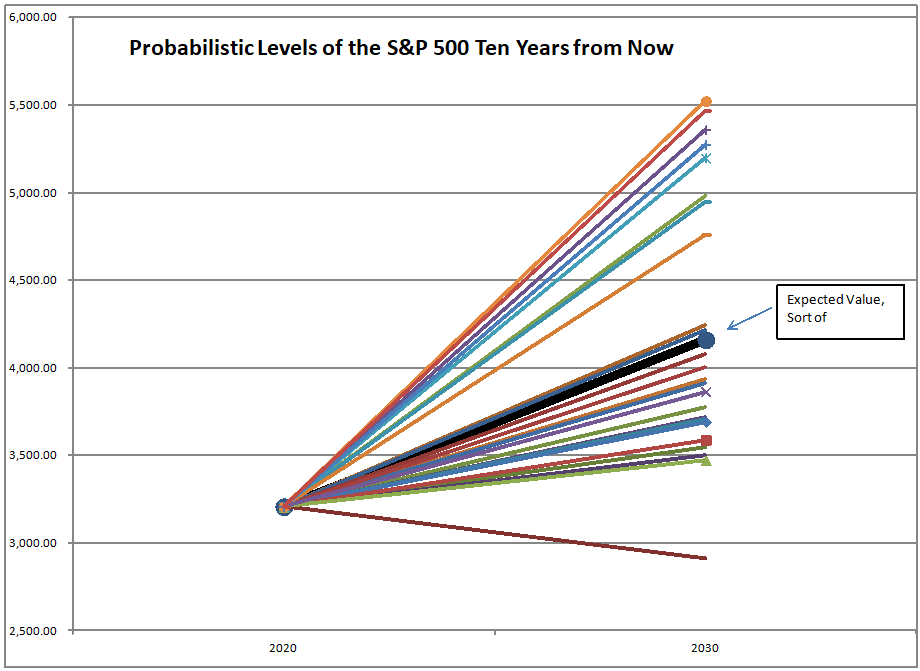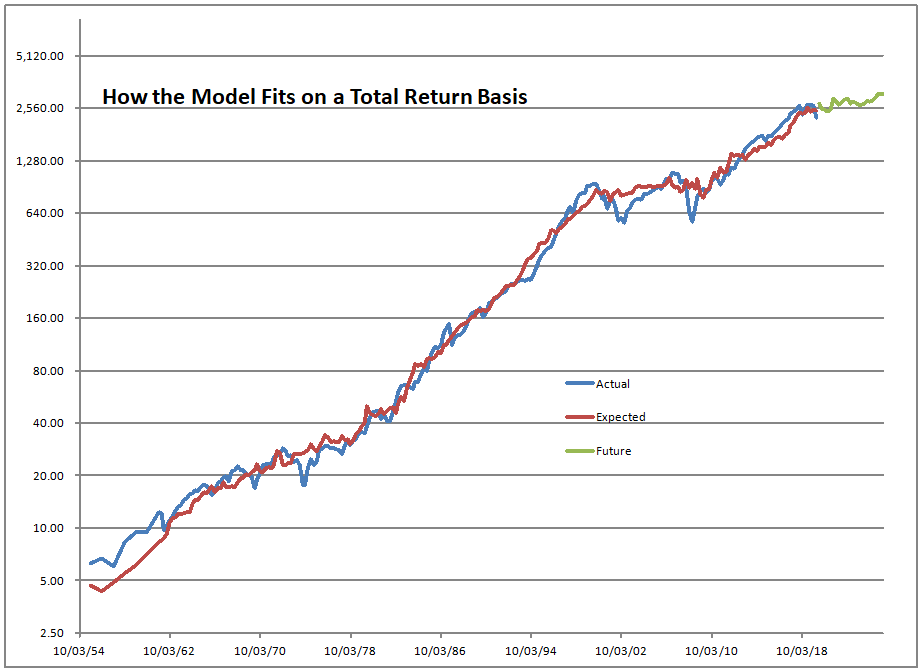Graphic Credit: Aleph Blog, natch… same for the rest of the graphs here. Data is from the Federal Reserve and Jeremy Siegel
As I said last time, a lot can happen in 3 months. At the end of March 2020, a rally was starting that would become a new bull market. At that time, the market was poised to deliver a return over the next 10 years of 6.84%/year. As I write this evening, after the rally the likely return over the next ten years is 4.63%/year.
Hee are a few more graphs, and then I will come to my main point for this post.

25 scenarios — one down, 24 up over ten years, with an average likely return of 4.63$/year.

In general, this model fits the data well, but who can tell for the future? This is likely the best estimate over a ten-year horizon.
So, do you go for stocks here with a likely return of 4.63%/year, versus the Barclays’ Aggregate at around 2.5%/year or cash at around 0.2%/year? You can hear the siren call of TINA (There Is No Alternative) loud and clear.
Let me peel this back a bit for a moment, as one who once managed a large portfolio of bonds. Why not always buy the highest yielding bonds? The answer that would come back from the bright students would be: don’t the highest yielding bonds default more?
The bond manager that buys without question the higher yielding names presumes stability in the financial markets, and likely the economy as well. Defaults can affect the realized yield a lot. You might be getting more yield today, but will you be able to realize those yields? In addition to losses from defaults, many managers lose value during times of credit stress because they are forced to sell marginal bonds that they are no longer sure will survive at distressed prices.
I think the estimate of returns that I have given on the S&P 500 is a reasonable estimate — it’s not a yield, but an estimate of dividend yield and capital gains. 4.63%/year over 10 year certainly beats bond handily. But do you have the fortitude, balance sheet, and time horizon to realize it?
More say they have it than actually do have it. The account application form at my firm stresses the risks of investing, and talks about stock investors needing a long time horizon. I still get people who panic. The present situation, given the novelty of a virus “crowning” (idiom for a whack to the head) the market, and the market largely ignores it makes many panic, assuming that there must be a big fall coming soon.
Eh? There might be such a fall. The S&P 500 could reach a new high in July. Who cares — that is why I run a 10-year model — to take the emotion out of this. If you are afraid of the market now, you should do one of three things:
- Sell your stock now — you are not fit for stock investing.
- Sell your stock now, and choose two points where you will reinvest. What is the lower S&P 500 that would give you comfort to invest? Second, if after an amount of time the market doesn’t fall to the level that you dream of, at what date would you admit that you were wrong, and reinvest then.
- Do half — sell half of your risk away, moving it to safety. Again, try to set a rule for when you would reinvest.
In general, I don’t believe that there is no alternative to stocks, and I don’t think stocks are cheap, but in general, the optimists triumph in investing. I have been shaving down risk positions, but with the Fed doing nutty things like QE infinity (whatever it takes), buying corporate bonds and doing direct lending, I don’t see how the markets fall hard now. The dollar may be worth less when it is done, but I think it is likely that you will have more ten years from now by investing in stocks and risky assets like stocks, than to invest in safe assets.
When the Fed shifts, things will be different. As Chuck Prince, infamous former CEO of Citigroup once said:
“When the music stops, in terms of liquidity, things will be complicated,” Prince said. “But as long as the music is playing, you’ve got to get up and dance.”
What we have learned 10 years after Chuck Prince told Wall St to keep dancing
As I wrote in my Easy In, Hard Out pieces, the Fed will have a hard time removing stimulus. They tried and the market slapped them. Now they live in a “Brave New World” where they wonder what will ever force them to change from a position from a position of ever increasing liquidity. They try to not let it leak into the real economy, so there is little inflation for now.
But there is no free lunch. Something will come to discipline the Fed, whether it is inflation, a currency crisis — who knows? At that point, “things will be complicated.”
So what do I do? I own assets that will survive bad scenarios, I raise a little cash, but I am largely invested in stocks. To me, that is something that balances offense and defense, and doesn’t just focus on one scenario, whether it is a disaster, or the Goldilocks scenario of TINA.


Your projection of future returns sounds like a lot of hot air…
Can you suggest something better?
The extremists are now toppling Abe Lincoln statues because he ended slavery… try saying that with a straight face unless you spent $70K per year being indoctrinated at university recently. It was bad enough when they tried to whitewash history by toppling statues, now they are also attacking historical figures that advanced their cause.
Destroying statues, cleansing history and wrecking economies are activities associated with the taliban and Khmer Rouge. Terrible economic suffering of the rich and poor alike.
Stupid is not associated with economic growth.
Long term, it pays to be optimistic. Short term, Buffett’s decision to wait on the sidelines until the crazies exhaust everyone’s patience may be prudent.
David – over too much of my investing career I have found myself in some version of your option 2. Carrying more cash than I would like waiting for the price I feel comfortable with – and then breaking down and buying just before the price drop I was looking for. Obviously there are a lot of individual factors, but what factors would you consider in deciding how long to wait for your price? Small buys and regularly re-assessing what the ideal entry point is are two items, but can you suggest others?
Another question. with respect to Jim, I think your model is the opposite of so much hot air. However, do you think there is a concern that QE, balance sheet expansion by the Fed and other central banks may cause the model to be less accurate going forward? If so how? I am thinking that the four statistics used in the model may not be comparable with the same statistics in the past due to CB participation or that consistently low interest rates will continue to push up multiples to sit consistently at levels that would previously been bubbles.